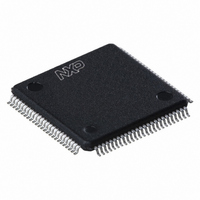LPC2157FBD100,551 NXP Semiconductors, LPC2157FBD100,551 Datasheet - Page 26

LPC2157FBD100,551
Manufacturer Part Number
LPC2157FBD100,551
Description
IC ARM7 MCU FLASH 512K 100LQFP
Manufacturer
NXP Semiconductors
Series
LPC2100r
Datasheet
1.LPC2157FBD100551.pdf
(45 pages)
Specifications of LPC2157FBD100,551
Program Memory Type
FLASH
Program Memory Size
512KB (512K x 8)
Package / Case
100-LQFP
Core Processor
ARM7
Core Size
16/32-Bit
Speed
60MHz
Connectivity
I²C, Microwire, SPI, SSI, SSP, UART/USART
Peripherals
Brown-out Detect/Reset, LCD, POR, PWM, WDT
Number Of I /o
38
Ram Size
32K x 8
Voltage - Supply (vcc/vdd)
3 V ~ 3.6 V
Data Converters
A/D 16x10b; D/A 1x10b
Oscillator Type
Internal
Operating Temperature
-40°C ~ 85°C
Processor Series
LPC21
Core
ARM7TDMI-S
Data Bus Width
16 bit, 32 bit
Data Ram Size
40 KB
Interface Type
I2C/SPI
Maximum Clock Frequency
60 MHz
Number Of Programmable I/os
38
Number Of Timers
2
Operating Supply Voltage
2.4 V to 3.6 V
Maximum Operating Temperature
+ 85 C
Mounting Style
SMD/SMT
3rd Party Development Tools
MDK-ARM, RL-ARM, ULINK2
Minimum Operating Temperature
- 40 C
On-chip Adc
8-ch x 10-bit
On-chip Dac
1-ch x 10-bit
Lead Free Status / RoHS Status
Lead free / RoHS Compliant
For Use With
568-4310 - EVAL BOARD LPC2158 W/LCD568-4297 - BOARD EVAL LPC21XX MCB2100622-1005 - USB IN-CIRCUIT PROG ARM7 LPC2K
Eeprom Size
-
Lead Free Status / Rohs Status
Lead free / RoHS Compliant
Other names
568-4524
935287348551
935287348551
Available stocks
Company
Part Number
Manufacturer
Quantity
Price
Company:
Part Number:
LPC2157FBD100,551
Manufacturer:
NXP Semiconductors
Quantity:
10 000
NXP Semiconductors
LPC2157_2158_1
Product data sheet
6.19.9 APB bus
6.20.1 EmbeddedICE
6.20 Emulation and debugging
In Power-down mode, the oscillator is shut down and the chip receives no internal clocks.
The processor state and registers, peripheral registers, and internal SRAM values are
preserved throughout Power-down mode and the logic levels of chip output pins remain
static. The Power-down mode can be terminated and normal operation resumed by either
a reset or certain specific interrupts that are able to function without clocks. Since all
dynamic operation of the chip is suspended, Power-down mode reduces chip power
consumption to nearly zero.
Selecting an external 32 kHz clock instead of the PCLK as a clock-source for the on-chip
RTC will enable the microcontroller to have the RTC active during Power-down mode.
Power-down current is increased with RTC active. However, it is significantly lower than in
Idle mode.
A Power Control for Peripherals feature allows individual peripherals to be turned off if
they are not needed in the application, resulting in additional power savings during active
and Idle mode.
The APB divider determines the relationship between the processor clock (CCLK) and the
clock used by peripheral devices (PCLK). The APB divider serves two purposes. The first
is to provide peripherals with the desired PCLK via APB bus so that they can operate at
the speed chosen for the ARM processor. In order to achieve this, the APB bus may be
slowed down to
properly at power-up (and its timing cannot be altered if it does not work since the APB
divider control registers reside on the APB bus), the default condition at reset is for the
APB bus to run at
is to allow power savings when an application does not require any peripherals to run at
the full processor rate. Because the APB divider is connected to the PLL output, the PLL
remains active (if it was running) during Idle mode.
The LPC2157/2158 supports emulation and debugging via a JTAG serial port. Debugging
functions are multiplexed with GPIOs on Port 1. This means that all communication, timer
and interface peripherals residing on Port 0 are available during the development and
debugging phase as they are when the application is run in the embedded system itself.
Standard ARM EmbeddedICE logic provides on-chip debug support. The debugging of
the target system requires a host computer running the debugger software and an
EmbeddedICE protocol convertor. EmbeddedICE protocol convertor converts the remote
debug protocol commands to the JTAG data needed to access the ARM core.
The ARM core has a Debug Communications Channel (DCC) function built-in. The DCC
allows a program running on the target to communicate with the host debugger or another
separate host without stopping the program flow or even entering the debug state. The
DCC is accessed as a co-processor 14 by the program running on the ARM7TDMI-S
core. The DCC allows the JTAG port to be used for sending and receiving data without
affecting the normal program flow. The DCC data and control registers are mapped in to
addresses in the EmbeddedICE logic.
1
2
1
to
4
of the processor clock rate. The second purpose of the APB divider
1
Rev. 01 — 15 October 2008
4
of the processor clock rate. Because the APB bus must work
Single-chip 16-bit/32-bit microcontrollers
LPC2157/2158
© NXP B.V. 2008. All rights reserved.
26 of 45
















